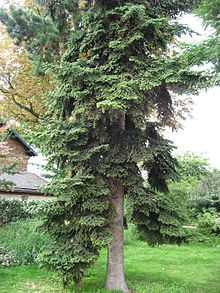Abies numidica
| Abies numidica Algerian fir | |
|---|---|
 | |
| Conservation status | |
| Scientific classification | |
| Kingdom: | Plantae |
| Division: | Pinophyta |
| Class: | Pinopsida |
| Order: | Pinales |
| Family: | Pinaceae |
| Genus: | Abies |
| Species: | A. numidica |
| Binomial name | |
| Abies numidica de Lannoy ex Carrière | |
Abies numidica (Algerian fir) is a species of fir, found only in Algeria, where it is endemic on Djebel Babor, the second-highest mountain (2,004 m) in the Algerian Tell Atlas.[1][2]
Description
Abies numidica is a medium-sized to large evergreen tree growing to 20–35 m tall, with a trunk up to 1 m diameter. The leaves are needle-like, moderately flattened, 1.5–2.5 cm long and 2–3 mm wide by 1 mm thick, glossy dark green with a patch of greenish-white stomata near the tip above, and with two greenish-white bands of stomata below. The tip of the leaf is variable, usually pointed, but sometimes slightly notched at the tip, particularly on slow-growing shoots on older trees. The cones are glaucous green with a pink or violet tinge, maturing brown, 10–20 cm long and 4 cm broad, with about 150–200 scales, each scale with a short bract (not visible on the closed cone) and two winged seeds; they disintegrate when mature to release the seeds.[2]
Distribution
Abies numidica grows in a high-altitude Mediterranean climate at 1,800–2,004 m (rarely down to 1,220 m) with an annual precipitation of 1,500–2,000 mm, the great majority of which falls as winter snow; the summers are warm and very dry. It is closely related to Abies pinsapo (Spanish fir), which occurs further west in the Rif mountains of Morocco and in southern Spain.[2]
Cultivation and uses
Algerian fir, Abies numidica, is occasionally grown as an ornamental tree in parks and larger gardens. It is valued among firs for its drought tolerance.
References
| Wikimedia Commons has media related to Abies numidica. |
- ↑ 1.0 1.1 Yahi, N., Knees, S. & Gardner, M. (2010). "Abies numidica". IUCN Red List of Threatened Species. Version 2013.2. International Union for Conservation of Nature. Retrieved 2013-11-10.
- ↑ 2.0 2.1 2.2 Farjon, A. (1990). Pinaceae. Drawings and Descriptions of the Genera. Koeltz Scientific Books ISBN 3-87429-298-3.
